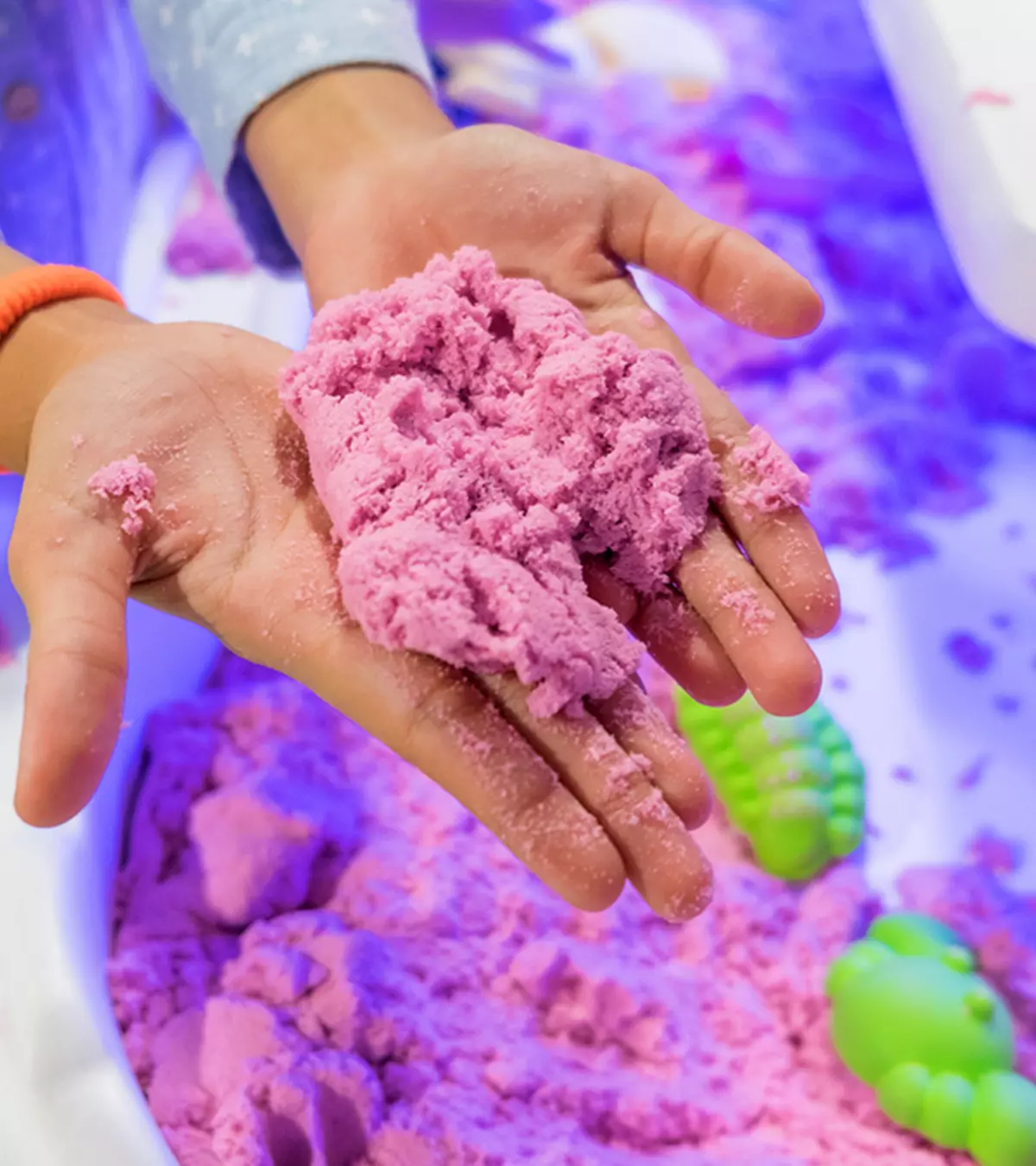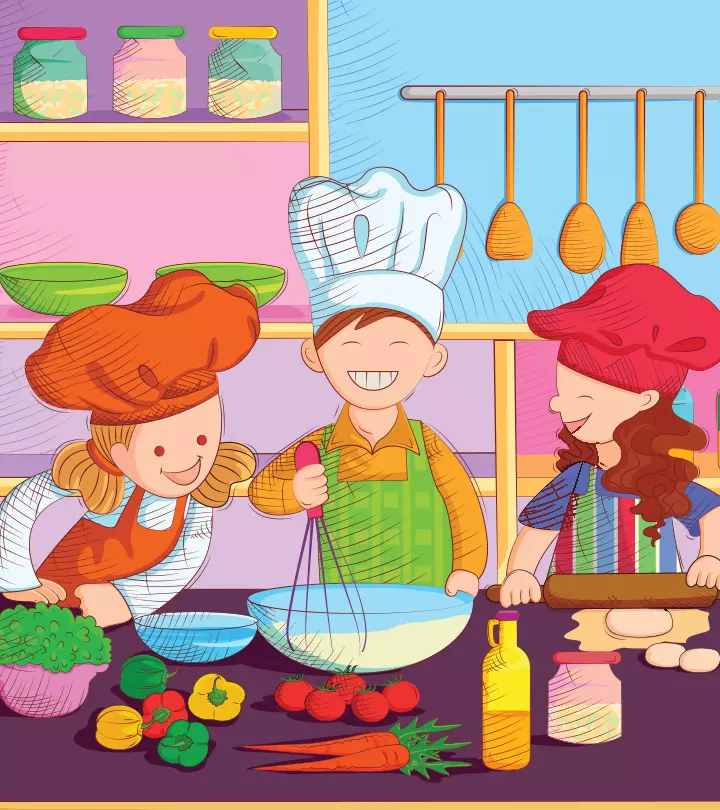
Image: Shutterstock
While some children enjoy their mealtime, others may be fussy with their food. They play, talk, or watch TV while eating, which deviates their interest from food. To avoid such situations, you can involve them in meal prep activities or consider trying cooking games for kids. These games can help tickle their taste buds for different cuisines. As they learn more about different flavors and textures, children also enjoy the creative cooking process. Cooking games for kids also provide an excellent opportunity for exploring their creative side, help promote teamwork, and give them an understanding of healthy eating habits.
Here are some of the best cooking games for kids. Even the fussiest eaters may want to try new recipes with these games.
Key Pointers
- Allowing your child to taste various ingredients, including sugar, lemon, honey, and so on, can be both entertaining and informative.
- When you cook or bake, let your child measure the ingredients.
- Turn a regular scavenger hunt into a cookie-cutter hunting game.
16 Cooking Games For Kids
All the games listed here are safe for children. But before trying cooking games for kids, you may want to check if your child has any food allergies and take necessary precautions.
1. Blind taste test

This game can be a fun challenge to offer children oral simulation, which will help them focus on their taste buds and appreciate various flavors and textures.
How to play
- Put various dishes on a table.
- Blindfold a player.
- Let the other players feed a spoon from each dish.
- The blindfolded player has to guess the name of the food.
- Older children can give clues to help.
- Every player gets to taste three dishes.
- Continue the same with all the players.
Viviane, a food blogger, shares her experience of playing the blind taste test game with her sister and her children. She says, ”When her (sister’s) kids heard about it, they got all excited and wanted to team up with their mom and me and play ‘the game’… It all started with a trip to the supermarket to buy ingredients for the challenge and the Sablés I made the day before. Initially there were supposed to be five ingredients for each team but we did not have any time left at the supermarket so we settled for the four already chosen. We also had water handy for contestants to wash up the previous taste… Without the visual association, the guessing offers a little challenge… It was a fun experience mostly. The kids enjoyed it as much as we did, it was hilarious how the boys got competitive. Although the blind tasting was filled with laughter for all, even the family who was watching (i).”
 Did you know?
Did you know?2. Eat the alphabet

If you have pre-schoolers who are just learning the alphabet, try this game to introduce them to different healthy foods they can eat across meals.
How to play
- Pick a letter for the day.
- Let children name healthy food items beginning with that letter and also eat them.
- For example, if the letter is ‘A’ they have to eat food items beginning with A like apples, avocados, anchovies, almonds, etc.
3. The tasting game

This simple game helps children understand the taste of individual ingredients used for cooking.
How to play
- Place a few small plastic bowls in a row.
- Put a different ingredient in each bowl.
- Now let the children taste items from each bowl.
- You can use various ingredients, including salt, pepper, paprika (keep some milk or bread handy if your child cannot handle spicy foods), honey, sugar, turmeric, lemon juice, and so on.
4. Pasta relay
If your child enjoys running around, this game is great for them to associate play with tasty food.
How to play
- Divide players into two teams.
- Place an empty bowl in front of each team.
- On the opposite side of the room, place two bowls filled with dry cooked pasta.
- Each team gets a ladle.
- When the game begins, the first players in line must run to the bowls filled with pasta, scoop out one ladle of pasta, and run back to the empty bowl.
- Then they pass the ladle to the next player.
- This game continues for three minutes or until the bowl goes empty.
- Whichever team fills the most amount of pasta in their bowl wins.
- Both teams get to eat the pasta after the game.
5. Cooking math

If your child is in primary school and is learning math concepts such as addition, subtraction, multiplication, division, fractions, etc., you can teach the same using foods.
How to play
- Get a plastic cake that can be cut into slices and attached back using Velcro strips.
- Let the children count the number of slices on the cake.
- Then cut each slice and tell them how it is represented in the fractions.
- You could also teach concepts of addition and subtraction with this game.
6. Boiled eggs
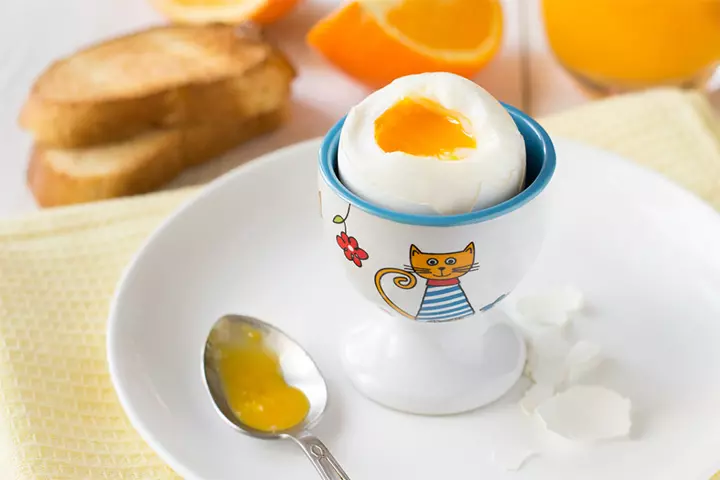
Teach your child how to boil an egg with this simple game.
How to play
- Place eggs in different bowls and put them on the hob.
- Let your child track each bowl’s temperature and time.
- Once done, cool, peel, and cut the eggs.
- Now, let them understand the temperature and time taken by the best and worst cooked eggs.
7. Measure and guess
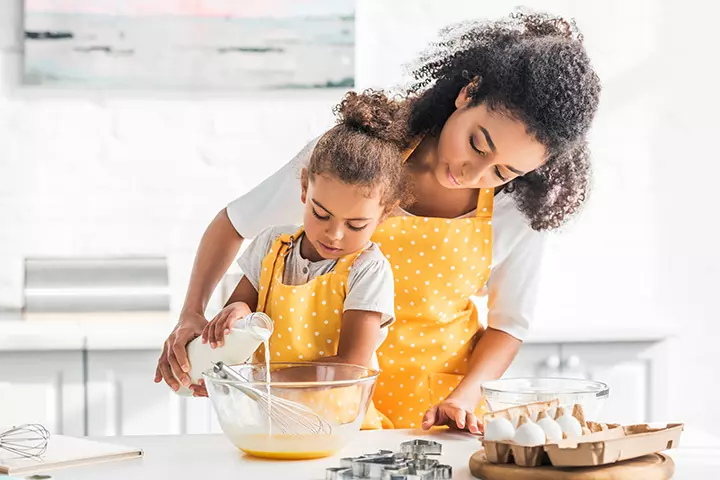
Make the cooking process a lot more entertaining with this game.
How to play
- Decide a food item to cook or bake.
- Measure out the ingredients and place them in different bowls.
- Let the children guess the amount of each ingredient.
- For example, if you are baking a cake, let your child guess how many cups of flour or eggs you have measured out.
8. Measure up
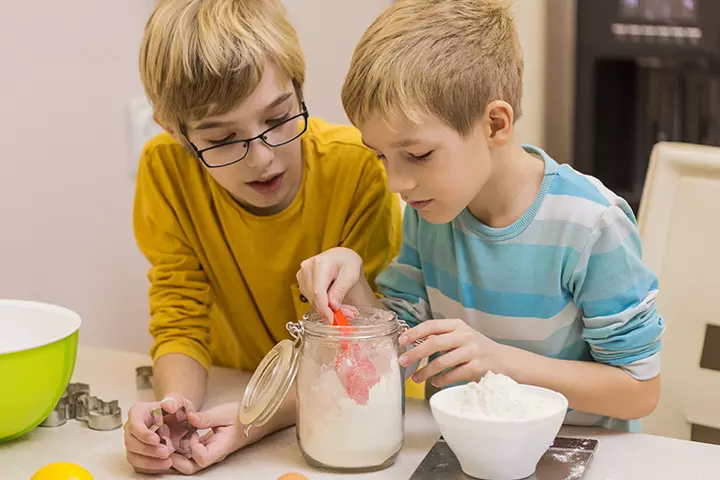
This is a fun variation of the ‘Measure and Guess’ game.
How to play
- Decide the dish you wish to cook or bake.
- Layout all the ingredients you will need for the dish on your counter.
- Let the children guess the amount of each ingredient you will need for the dish.
- You may put out some ingredients you will not need as well to confuse the players.
- Reward them with candy when the guess is right. And if they go wrong, then correct them and explain the right measurements.
9. What can you eat?

This game is for juniors, particularly preschoolers to help them understand what is edible and what is not. You may even turn it into a contest.
How to play
- Get some flashcards printed with some images from the internet. Pick images that have both food and non-food items.
- Show these flashcards to children, one after the other.
- They have to say whether they can eat the item on the card or not.
- If you do not want to print flashcards, you may simply write a list of food and non-food items on a sheet of paper and read out the names one by one.
- You may include any foods, such as fruits, vegetables, grains, insects, shoes, socks, meat, chicken, etc.
 Do remember
Do remember10. Cookie cutter hunt
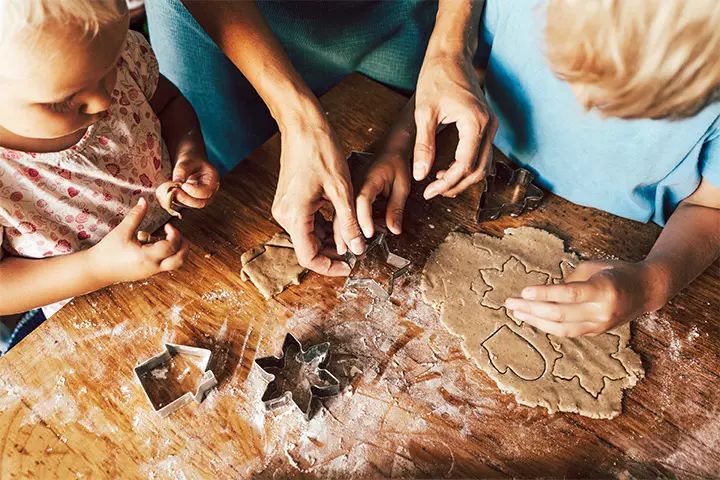
This joyful activity is similar to a regular scavenger hunt but includes only cookie cutters. The game ends with freshly baked cookies for everyone. Win-win for all!
How to play
- Hide several cookie cutters at random places in your home.
- Give the children some clues. For example, for a star-shaped cookie cutter, you can write, “The cookie-cutter that twinkles in the sky.”
- Let the children collect all the cookie cutters.
- Then give them some cookie dough to roll out and cut with their cookie cutters.
- Finally, bake all the cookies and enjoy them.
11. Superhero food
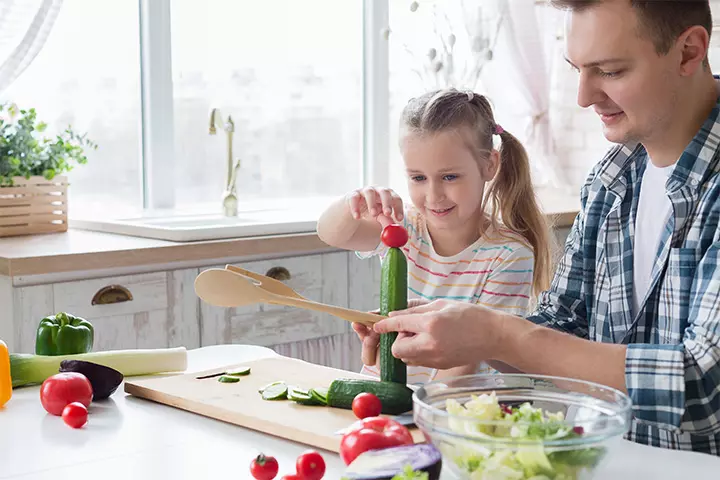
Ever heard of superhero foods? Try this fun game to take the enjoyment to the next level!
How to play
- Mix all the ingredients you will need for a dish and cook it.
- Give it a superhero name. For example, you can name blueberry muffins ‘Captain America’ or strawberry cake ‘Iron Man.’ You can also add spinach or other greens to bread and muffins and name them ‘Hulk.’
12. Bread in a bag

Baking a loaf of bread can be an engaging and fast activity that everyone in the family can enjoy.
How to play
- Add all the ingredients for making bread in a zip lock bag and mix them.
- Knead, divide into loaf pans, and bake.
- You can bake them in any shape you like.
13. Table setting game

What follows cooking? Eating at a neat and tidy dining table. Isn’t it? Yes, the table setting is also an important part of preparing food. Let your child move up from pretend play to actually setting up a dining table.
How to play
- Divide the players into two teams.
- Let each team take one side of the table.
- Layout all the cutlery on the counter.
- Set a timer of one minute and let each team decorate the table as they like.
14. Recipe scramble
Ideal for older children, this challenging cooking activity for kids can help them learn cooking and improve their logical thinking skills.
How to play
- Divide the children into two teams.
- Give each team a recipe written with the name of the ingredients scrambled.
- Next, the teams have to decipher the names of the ingredients.
- Once they have the unscrambled list, they have to collect the ingredients and cook the dish.
15. Invent a recipe
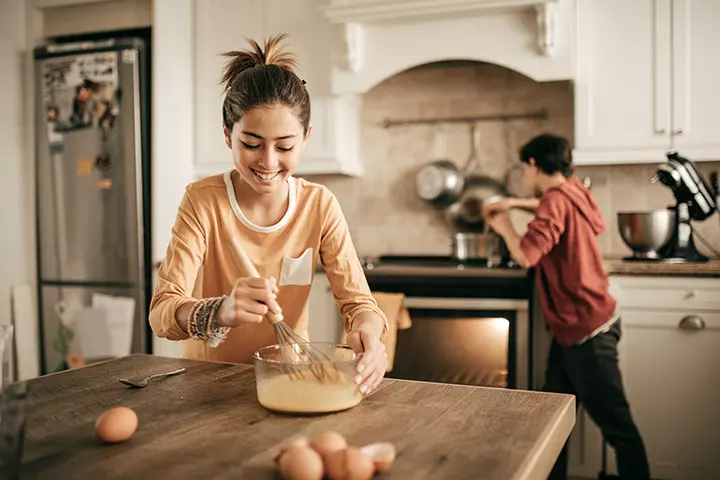
What is better than letting the children use their imagination to create recipes and invent unique cooking wonders?
How to play
- Go to the kitchen and explain various ingredients used in everyday cooking.
- Let the children put these ingredients together in any combination they want.
- Help them cook their signature dish.
- Taste and validate the dish with your child.
16. Chopped

Chopped is a cooking game inspired by the cooking show of the same name on Food Network. It makes an interesting food game for kids that you can even turn into a contest.
- Prepare surprise baskets as per the number of players, each containing three ingredients from different food categories (e.g., a rice cake, an orange, banana chips).
- Ask the children to make a dish using the ingredients in a fixed time. It will be judged based on the taste and presentation.
- The idea is to test the creativity and presence of mind of the players as to how they utilize the “disconnected” ingredients to create a dish of their own.
- You would also need to make a pantry of common extra ingredients such as salt, sugar, ketchup, butter, etc.
- To ensure safety, select ingredients that do not need cooking on a fire or stove. Use this opportunity to have them try out fireless cooking for kids.
Frequently Asked Questions
1. Are cooking games safe for children to play?
Yes, as long as they are played with parental supervision, cooking games are safe to play. Special attention must be given when children use the stove, knives, or other kitchen appliances while playing.
2. What age is appropriate for children to start playing cooking games?
Children older than five years can be involved in playing cooking games.
3. How can cooking games enhance my child’s learning experience?
Cooking games and activities often teach basic math, science, and nutrition concepts in fun and engaging ways and help kids learn about nutrition and healthy food choices. These games also encourage hands-on experience and improve their critical thinking and problem-solving skills. Moreover, they foster creativity and independence, thus building children’s confidence.
4. Are cooking games educational?
Yes, cooking games may teach children about various foods, their nutritional benefits, the seasons in which they grow, cooking measurements, and food safety and storage.
5. Are cooking games a good way to bond with children?
Cooking games are a great way to bond with children. These activities can encourage communication, promote learning new things, and teach children to share and cooperate in teams.
Children can be fussy and picky when it comes to eating, but when you engage them in cooking, they may eventually enjoy a variety of tastes. So, choose from these cooking games for kids to let them explore the process of preparing, collecting, and baking or cooking dishes. Whether counting or guessing games, measuring games, tasting foods, or inventing new recipes, these games will surely enhance your child’s interest in the culinary world. Furthermore, you may also include these games in family get-togethers or casual dinners with friends.
Infographic: Fun Child-Friendly Games Based On Cooking And Food
Children are always fascinated by how their food is cooked or baked. So, let’s make your cooking time a bonding time with your children by including them in the process. The infographic below includes fun and educational cooking and food-themed games you can try with your children. Illustration: Momjunction Design Team
Illustration: Engaging Cooking Games For Kids To Play At Home

Image: Stable Diffusion/MomJunction Design Team
Parents can involve their children in the kitchen to enjoy the art of cooking. As mentioned in the video, introduce them to various kitchen tools and play fun activities.
Personal Experience: Source
MomJunction articles include first-hand experiences to provide you with better insights through real-life narratives. Here are the sources of personal accounts referenced in this article.
i. Teaming up for the blind taste test;https://thetastebudz.wordpress.com/2011/07/10/teaming-up-for-the-blind-taste-test/
Community Experiences
Join the conversation and become a part of our nurturing community! Share your stories, experiences, and insights to connect with fellow parents.
Read full bio of Elisa Yi
Read full bio of Nisha Bharatan
Read full bio of Harshita Makvana
Read full bio of Trisha Chakraborty
















